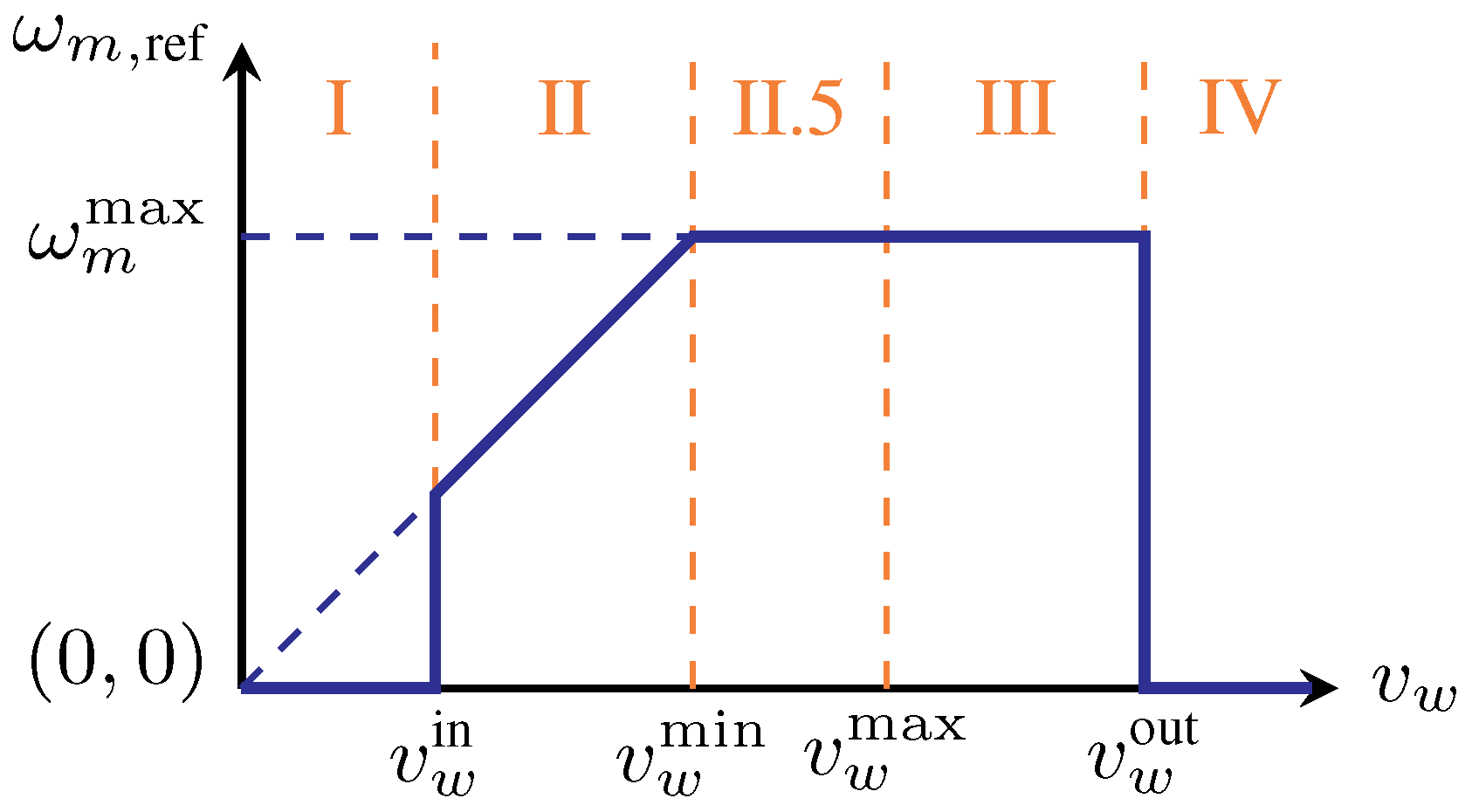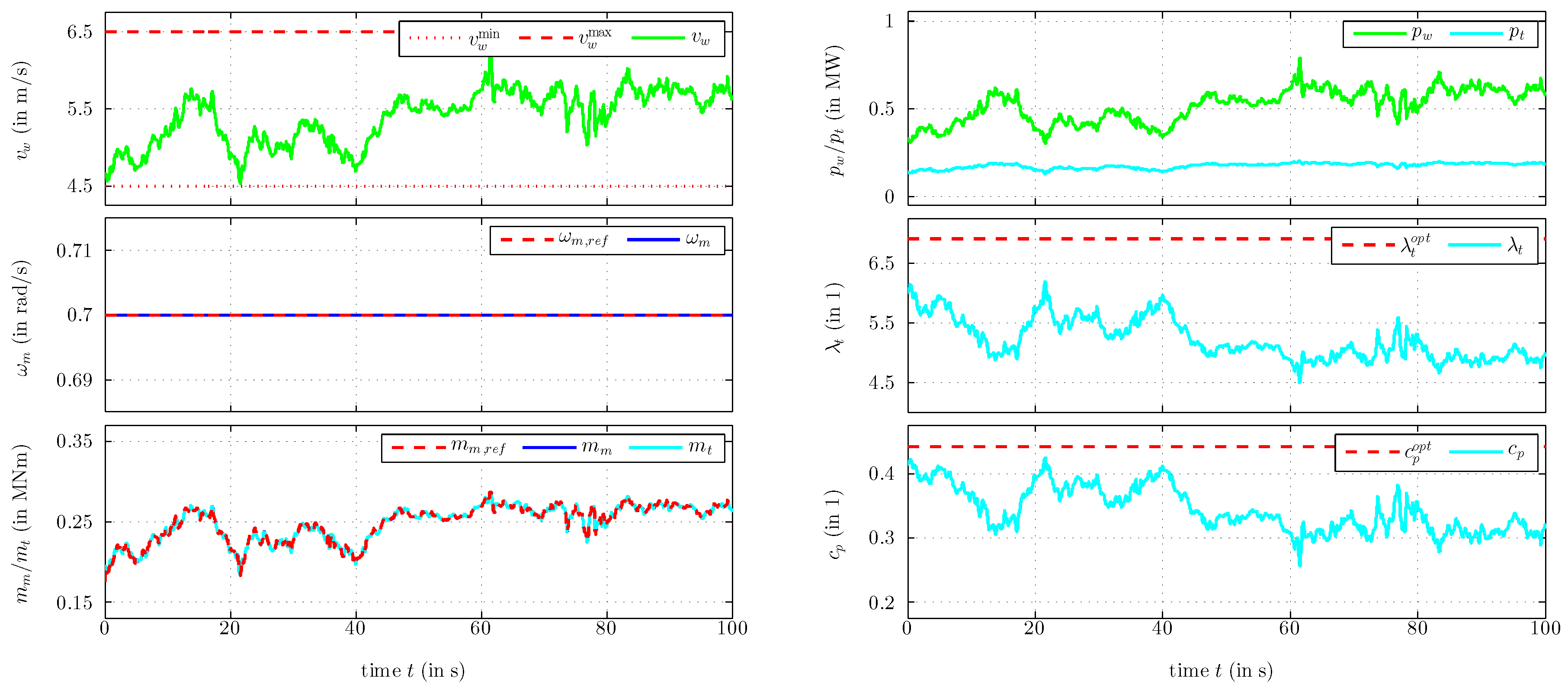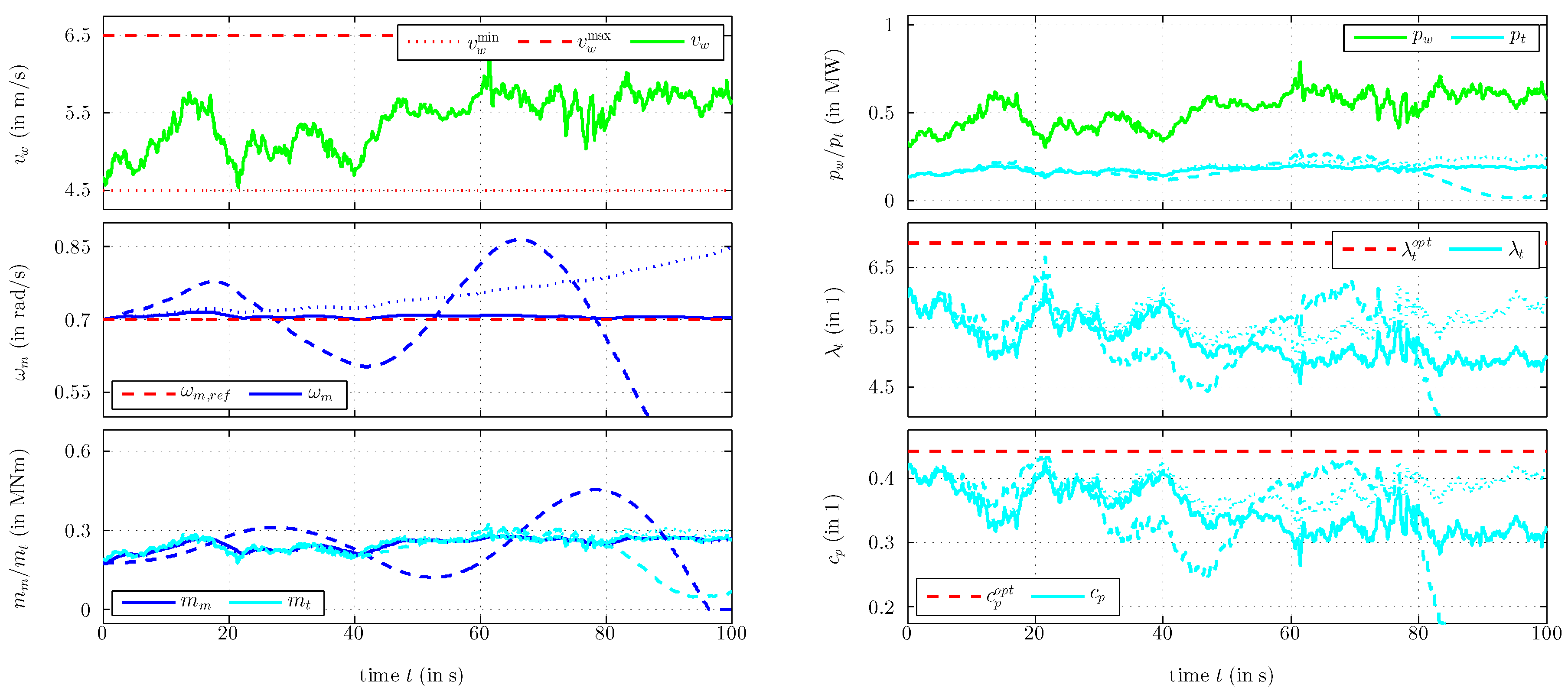Local Stability Analysis and Controller Design for Speed-Controlled Wind Turbine Systems in Regime II.5
Abstract
:1. Introduction
2. Dynamics of the System
2.1. Dynamics of the Mechanics
2.2. Dynamics of the Underlying Control Loop of the Machine Torque
2.3. Overall Dynamics
3. Linearization
4. Stability Analysis
5. Controller Design
5.1. Controller Parameter Tuning
5.2. Anti-Wind Up and Saturation
6. Simulation Results
- Scenario 1: Control performance for a constant but maximal speed reference to illustrate stability and set-point tracking control performance.
- Scenario 2: Control performance for an arbitrarily time-varying speed reference to illustrate stability and reference tracking control performance at different operation points.
- Scenario 3: Control performance for a constant but maximal speed reference for three different controller tunings to illustrate the effect of tuning on stability and set-point tracking control performance.
- Scenario 4: Control performance for an arbitrarily time-varying speed reference for three different controller tunings to illustrate the effect of tuning on stability and reference tracking control performance at different operation points.
7. Conclusions
Author Contributions
Funding
Conflicts of Interest
Nomenclature
| Symbols | Description |
| , , | operation point, initial value, small signal approximation |
| , , | turbine power, turbine torque and turbine radius |
| , , , | wind power, air density, gear box ratio and total inertia |
| , , , , | machine speed, its reference, minimum, maximum and critical operation point |
| , , , | wind speed, its minimum, maximum and critical operation point |
| , | bounds the range of wind speeds, where the WTS is in operation |
| , , | pitch angle, its critical and optimal operation point |
| , , | machine torque, its minimum and maximum |
| , | machine torque reference and its saturated value |
| , , , , | tip speed ratio, its minimum, maximum and critical/optimal operation point |
| , , –, h | power factor, its optimum, coefficients and function of the power factor curve |
| , | gain and time constant of the underlying machine torque controller |
| , , | integral state, proportional gain and integral gain of the PI-controller |
| , , | design parameter and saturation function, higher order terms of Taylor appr. |
| , , v, y | state and disturbance vector, reference input and output of the system |
| , , , | system and disturbance matrix, input and output vector of the system |
| , , , | characteristic polynomial of the linearized system and its coefficients |
| , , , | desired characteristic polynomial of the controller design and its poles |
| := | dynamics of machine speed, machine torque and integral state |
| , , | derivative of in respect of machine speed, wind speed and pitch angle |
| , , | critical operation point of , functions to characterize |
| , , , , | operation sets of tip speed ratio and regime II.5, (parts of) boundary of |
References
- Durstewitz, M.; Berkhout, V.; Cernusko, R.; Faulstich, S.; Hahn, B.; Hirsch, J.; Kulla, S.; Pfaffel, S.; Rohrig, K.; Rubel, K.; et al. Windenergiereport Deutschland 2016; Technical Report; Fraunhofer-Institut für Windenergie und Energiesystemtechnik (IWES): Kassel, Germany, 2017. [Google Scholar]
- Ackermann, T. (Ed.) Wind Power in Power Systems; John Wiley & Sons, Ltd.: Chichester, UK, 2012. [Google Scholar]
- Gasch, R.; Twele, J. Windkraftanlagen—Grundlagen, Entwurf, Planung und Betrieb, 8th ed.; Vieweg + Teubner Verlag: Berlin/Heidelberg, Germany, 2013. [Google Scholar]
- Manwell, J.F.; McGowan, J.G.; Rogers, A.L. Wind Energy Explained: Theory, Design and Application; John Wiley & Sons: Hoboken, NJ, UAS, 2009. [Google Scholar]
- Quaschning, V. Regenerative Energiesysteme; Hanser Verlag: Munich, Germany, 2011. [Google Scholar]
- Dirscherl, C.; Hackl, C.; Schechner, K. Modellierung und Regelung von modernen Windkraftanlagen: Eine Einführung. In Elektrische Antriebe—Regelung von Antriebssystemen; Schröder, D., Ed.; Springer: Berlin/Heidelberg, Germany, 2015; Chapter 24; pp. 1540–1614. [Google Scholar]
- Pao, L.Y.; Johnson, K.E. Control of Wind Turbines: Approaches, Challenges, and recent Developments. IEEE Control Syst. Mag. 2011, 31, 44–62. [Google Scholar] [CrossRef]
- Mullen, J.; Hoagg, J.B. Wind turbine torque control for unsteady wind speeds using approximate-angular-acceleration feedback. In Proceedings of the 2013 IEEE 52nd Annual Conference on Decision and Control (CDC), Florence, Italy, 10–13 December 2013; pp. 397–402. [Google Scholar]
- Muller, S.; Deicke, M.; De Doncker, R.W. Doubly fed induction generator systems for wind turbines. IEEE Ind. Appl. Mag. 2002, 8, 26–33. [Google Scholar] [CrossRef]
- Slootweg, J.G.; de Haan, S.W.H.; Polinder, H.; Kling, W.L. General model for representing variable speed wind turbines in power system dynamics simulations. IEEE Trans. Power Syst. 2003, 18, 144–151. [Google Scholar] [CrossRef]
- Hand, M.M.; Balas, M.J. Systematic controller design methodology for variable-speed wind turbines. Wind Eng. 2000, 24, 169–187. [Google Scholar] [CrossRef]
- Burton, T.; Jenkins, N.; Sharpe, D.; Bossanyi, E. Wind Energy Handbook; John Wiley & Sons: Hoboken, NJ, UAS, 2011. [Google Scholar]
- Bossanyi, E.A. The design of closed loop controllers for wind turbines. Wind Energy 2000, 3, 149–163. [Google Scholar] [CrossRef]
- Bossanyi, E.; JENKINS, N. Electrical Aspects of Variable Speed Operation of Horizontal Axis Wind Turbine Generators; Technical Report, ETSU W/33/00221/REP; Energy Technology Support Unit: Harwell, UK, 1994. [Google Scholar]
- Bossanyi, E. Wind turbine control for load reduction. Wind Energy 2003, 6, 229–244. [Google Scholar] [CrossRef]
- Dirscherl, C.; Hackl, C.M. Dynamic power flow in wind turbine systems with doubly-fed induction generator. In Proceedings of the 2016 IEEE International Energy Conference (ENERGYCON), Leuven, Belgium, 4–8 April 2016; pp. 1–6. [Google Scholar] [CrossRef]
- Johnson, G.L. Wind Energy Systems. Electronic Edition, 2006. Available online: https://www.ece.k-state.edu/people/faculty/gjohnson/files/Windbook.pdf (accessed on 26 March 2018).
- Bhattacharyya, S.; Datta, A.; Keel, L. Linear Control Theory: Structure, Robustness, and Optimization; Automation and Control Engineering, CRC Press: Boca Raton, FL, USA, 2009. [Google Scholar]
- Ackermann, J. Robust Control: The Parameter Space Approach, 2nd ed.; Springer: London, UK, 2002. [Google Scholar]
- Hackl, C.M. Non-Identifier Based Adaptive Control in Mechatronics: Theory and Application; Number SPIN 86365067 in Lecture Notes in Control and Information Sciences; Springer: Berlin, Germany, 2017. [Google Scholar]
- Heier, S. Windkraftanlagen: Systemauslegung, Netzintegration und Regelung, 5th ed.; Vieweg + Teubner Verlag: Berlin/Heidelberg, Germany, 2009. [Google Scholar]








| Description | Symbols & Values with Unit |
|---|---|
| Matlab/Simulink | solver (fixed step): ode4, sampling time for model |
| sampling time for (discretized) controller implementation | |
| WTS parameter | , , , , , |
| Power factor | , , , , , , |
| , | |
| Controller | , , , , , |
| parameter | , ⇒, , |
© 2018 by the authors. Licensee MDPI, Basel, Switzerland. This article is an open access article distributed under the terms and conditions of the Creative Commons Attribution (CC BY) license (http://creativecommons.org/licenses/by/4.0/).
Share and Cite
Dirscherl, C.; Hackl, C.M. Local Stability Analysis and Controller Design for Speed-Controlled Wind Turbine Systems in Regime II.5. Energies 2018, 11, 1251. https://doi.org/10.3390/en11051251
Dirscherl C, Hackl CM. Local Stability Analysis and Controller Design for Speed-Controlled Wind Turbine Systems in Regime II.5. Energies. 2018; 11(5):1251. https://doi.org/10.3390/en11051251
Chicago/Turabian StyleDirscherl, Christian, and Christoph M. Hackl. 2018. "Local Stability Analysis and Controller Design for Speed-Controlled Wind Turbine Systems in Regime II.5" Energies 11, no. 5: 1251. https://doi.org/10.3390/en11051251





